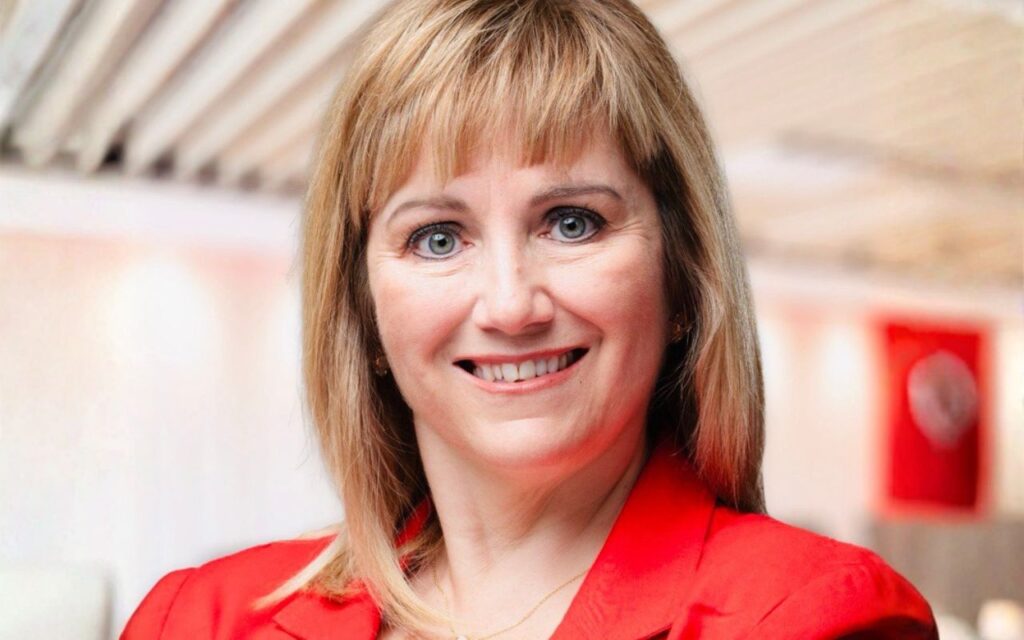
Jennifer Stewart: Candace, you’re at the helm of the Canadian Chamber of Commerce. It’s one of the most powerful business organizations in our country. But can we rewind a little bit and talk about what path led you here?
Candace Laing: Well, I’d have to go all the way back to the family farm in Saskatchewan, where I grew up. Jennifer, if you grew up on a farm, everybody pitches in and takes on certain jobs. But if you start breaking expensive farm equipment and your helping starts to cause damage, maybe your family says, “Okay, maybe it’s okay that you go off to business school and don’t stay on the farm with us – but you’re welcome anytime to come back and help.”
And so that was the start of my path. I love the farm, I love going back today, and it is very grounding for me. But my natural talents and gifts took me to business school, and that’s where I started my career – and still am today.
Catherine Clark: You know what I love about that? One of the things talked about a lot in business circles – especially startups – is to “break things.” So clearly, you had that lesson down pat right from the start! Now you’re not breaking physical farm equipment; you’re breaking ways of thinking and rebuilding new ones. Can you talk about some of the lessons from growing up on a farm that stuck with you as a leader?
Candace Laing: Well, the obvious one that gets talked about a lot is work ethic, right? Everybody pitches in if you’re on the farm. But there’s also this notion that if something needs to be done, it is up to you. The ability and willingness to engage – you’re never really sitting back – is so important.
It’s easy to think, “Well, maybe that’s not for me.” But on the farm, it’s for everybody. If you’re there, you’re part of the action, and you lean in and help. It’s everything from taking care of your own garbage to solving every problem together as a team. Everybody pitches in. So leaning in and engaging comes alongside that work ethic for sure.
Jennifer Stewart: Candace, when you were a little girl, when did you realize that you wanted to go to business school? You mentioned that your strengths weren’t necessarily in managing the farm equipment, but when did business dawn on you as something you could really grasp and succeed in?
Candace Laing: Okay, I’ll share two things.
First, my dad tells this story, as does my mom. There was no daycare on the farm, so as a little one, you were always in tow. My brother would stay put, fascinated by the auger running and watching everything. Me? I’d be off following a butterfly or exploring – interested in creating and other things I could do on the farm, rather than doing the task at hand, like moving the grain that day. I sort of knew some of those traits were different between me and my brother, who I’d say was born the farmer – and he still runs the operation with his family.
The second thing that ignited my interest in business and leadership was watching my dad. He would work all day on the farm, then shower, have dinner, and head off to board meetings – maybe the community rec board to keep the rinks going, or the credit union board to keep services available in the community. I just thought everyone did that – pitch in and contribute in your community. That was leadership too.
And then there was one other person, a neighbor named Joan. She’s passed now, but I remember seeing her drive past our farm, heading into Swift Current, Saskatchewan. She was the mall administrator. As a teenage girl in the 80s, I thought the mall was pretty cool. But she ran it – often the only woman in the room, dressed in business suits, with so many stories about her work and the community. Seeing her made me think, if she can do it, maybe I can too. That inspired me to want to be that woman in business.
Catherine Clark: You have this fascinating background that combines absolutely unequivocal hard work from growing up on a farm, a giving-back element inspired by your dad, and a female role model who showed you it’s possible to be the only woman in a room and lead successfully. In your current role – and maybe in previous roles too – you’ve walked into situations as a leading woman in the room. Can you share what goes through your head in those moments? Do you feel completely comfortable, or do you have to work yourself up?
Candace Laing: Oh, definitely work myself up to that point. I would say my career has been a lifelong journey, somewhat of a crisis of belonging. I maybe didn’t think I belonged on the farm, given my interests and aptitudes. And then in the world of business, the culture has historically been built by men for men. We’re only starting now to bring diversity into business culture, which is so important. That’s a passion of mine, because leadership needs a balance of masculine and feminine qualities.
So often in my career, I’ve been the only woman in the room. I spent more than a decade in a very male-dominated industry. That feeling of do I belong here? and making sure I’m resilient – I’ve had so many nudges along the way. Some of the most critical nudges came from women, but the majority came from men, saying: “Yes, you can. Yes, you should be here. Go for this opportunity or this position.”
I have mixed feelings about that. I’m grateful for those nudges, and I love conversations like this because I hope they nudge others too. But looking back, I think, why didn’t I have that within me along the way? That’s the human experience – struggling and finding your way to a place where you feel enough, where you belong, and hopefully relying less on external nudges as you progress.
Jennifer Stewart: In your role now, how do you take that lesson – of relying less on external nudges – and help push other female leaders into executive roles within the Canadian ecosystem?
Candace Laing: Discussions like this, being transparent and open about my journey, are part of the goal. I want others to see that you don’t make it on your own. If we don’t share, it’s easy for women and others to use false measuring sticks – they see the results but not the inputs. By sharing the journey, we can help accelerate internal growth for others. Vulnerability is critical here because it allows people to see themselves on the journey, rather than think, this isn’t my path. That’s a sad outcome I hope to impact.
Catherine Clark: You mentioned vulnerability, which can be hard for women in leadership who’ve fought so hard to get there. What advice do you give women who want to lead but struggle with fear, self-doubt, or imposter syndrome?
Candace Laing: When we talk about gender equality, it’s easy to focus only on external barriers – and they are real. But I also challenge women to consider internal barriers: how we show up differently for job postings, how we balance self-care and life roles. We own part of that. If we don’t challenge ourselves, we won’t succeed.
I also had to manage some of my own behaviors. Early in my career in male-dominated spaces, I inadvertently perpetuated biases toward women – signaling deference where I shouldn’t. Simple things, like serving cookies at meetings: I realized if I’m the only woman in the room, doing small “kind” gestures can unintentionally reinforce old dynamics. Now? I make sure everyone manages themselves – I’m there to lead, not serve.
Jennifer Stewart: Candace, you stepped into this role at a time when Canadian businesses are facing so much uncertainty – from inflation to geopolitical shifts to questions about the future of work. What do you see as the biggest challenges ahead?
Candace Laing: Oh, gosh. In terms of where I hope to help and leave a mark: as much as business needs supportive policy to thrive, we’re also in a time where business needs to lead – to be comfortable leading and lean into that agency.
If business is going to do that, we need all leaders to be able to step up. That comes back to what you mentioned, Catherine, about vulnerability – it’s also about connection. Connection to our communities and our businesses. Being comfortable in vulnerability allows leaders to truly connect with people.
At a time when we’re looking at a reinvention of Canada and ourselves, connection plays a huge part in our path forward. Business has a huge opportunity to lead, and that’s also an opportunity for individual leaders to grow and shine. That’s what I hope to contribute to.
Catherine Clark: You’re leading an organization with a long and important history in Canada and the Canadian business community. But there aren’t a lot of examples of women at the top. How are you approaching your role differently than past leaders?
Candace Laing: Well, here’s an interesting fact: the majority of leaders in the chamber network and in chambers across the country happen to be women. I feel in really strong, supportive company. We meet often, have an annual general meeting, a convention, and I draw inspiration from those community chambers.
When it comes to tough issues – whether homelessness, housing, or other challenges – my approach is to turn to our grassroots and see how communities convene themselves to solve problems. That’s actually very close to the farm mentality: it works because everyone pitches in, leans in, and asks, how can we solve this together? Those circles often give us the best solutions to scale up.
Jennifer Stewart: Candace, if you could go back and give that little girl on the farm – the one chasing butterflies – a piece of advice, what would it be?
Candace Laing: One early piece of advice from my first leadership coach was: trust the process. Leadership is a process of becoming. I wouldn’t tell that little girl she has to be all who she is on day one – what would be the point? Embrace the journey.
That same coach also told me early in my 20s: I don’t see you being the leader I know you can be. It was tough but supportive advice. There’s always space for growth. Embrace it, trust it, and at the end of that journey, you reach a place where you can fully embrace your self-worth.







